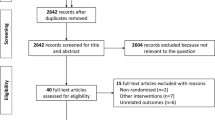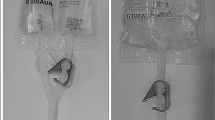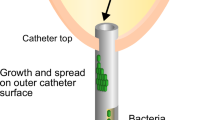Abstract
Study Design
Systematic Review.
Objectives
To review systematically the clinical evidence of the effectiveness of various intermittent catheter cleaning methods that have been proposed as methods to prepare catheters for reuse.
Methods
A keyword search in Medline, Excerpta Medica dataBASE, the Cumulative Index to Nursing and Allied Health Literature, Web of Science and Cochrane Central Register of Controlled Trials, was undertaken to identify all English, Russian and German language literature evaluating the effectiveness of various intermittent catheter cleaning methods. Studies selected for review included analytical experimental, prospective cohort and cross-sectional. Cleaning methods reviewed included heat-based sterilization, chemical cleaning solutions, mechanical abrasion, photocatalytic sterilization, and combined methods.
Results
Overall, 12 studies were included. Heat-based sterilization and mechanical abrasion methods were either not effective or damaged the physical properties of catheters. Two studies reported evidence that their chemical cleaning methods (i.e., soaked catheters in a 70% alcohol solution for 5 min or combined approach detergent wash followed by soaking in Milton sterilizing fluid also known as the Milton method) both preserved the structural integrity of their catheters and were bactericidal.
Conclusions
Numerous cleaning methods resulted in the destruction of catheters. However, there are two reported cleaning methods, submersion for 5 min in 70% alcohol and the “Milton method”, that eliminate bacterial colonization while leaving the physical properties of the catheters unchanged. While these cleaning methods are promising, each was published in just one study, therefore higher-powered / longitudinal studies confirming the safety and efficacy of these cleaning methods must be obtained before current clinical recommendations can be modified.
Similar content being viewed by others
Login or create a free account to read this content
Gain free access to this article, as well as selected content from this journal and more on nature.com
or
Data availability
The datasets generated and / or analysed during the current study are available from the corresponding author.
References
Bakke A, Irgens M, Malt F, Hoisreter P. Clean intermittent catheterisation performing abilities, aversive experiences and distress. Paraplegia. 1993;31:288–97.
Sun A, Comiter C, Elliott C. The cost of a catheter: An environmental perspective on single use clean intermittent catheterization. Neurourol Urodyn. 2018;37:2204–8.
Guttmann L, Frankel H. The value of intermittent catheterisation in the early management of traumatic paraplegia and tetraplegia. Paraplegia. 1966;4:63–84.
Lapides J, Diokno A, Silber S, Lowe B. Clean, intermittent self-catheterization in the treatment of urinary tract disease. J Urol. 1972;107:458–61.
Hill T, Baverstock R, Carlson K, Estey E, Gray G, Hill D, et al. Best practices for the treatment and prevention of urinary tract infection in the spinal cord injured population: The Alberta context Bladder management in the context of a spinal cord injury. Can Urol Assoc J. 2012;77:122–30.
Groen J, Pannek J, Castro Diaz D, Popolo G, Gross T, Hamid R, et al. Summary of European Association of Urology (EAU) Guidelines on Neuro-Urology. Eur Urol. 2016;69:324–33.
Wyndaele J-J, Brauner A, Geerlings S, Bela K, Peter T, Bjerklund-Johanson T. Clean intermittent catheterization and urinary tract infection: Review and guide for future research. BJU Int. 2012;110:E910–17.
Kovindha A, Mai WNC, Madersbacher H. Reused silicone catheter for clean intermittent catheterization (CIC): Is it safe for spinal cord-injured (SCI) men? Spinal Cord. 2004;42:638–42.
Prieto J, Murphy C, Moore K, Fader M. WITHDRAWN: Intermittent Catheterisation for Long-Term Bladder Management. Cochrane Database Syst Rev. 2014;10:CD006008 https://doi.org/10.1002/14651858.CD006008.pub3. SepUpdate in: Cochrane Database Syst Rev. 2017 Aug 08;8:CD006008. PMID: 25208303.
Christison K, Walter M, Wyndaele J-J, Kennelly M, Kessler T, Noonan V, et al. Intermittent catheterization: The devil is in the details. J Neurotrauma. 2018;35:985–89.
Gould C, Umscheid C, Agarwal R, Kuntz G, Pegues D. Healthcare Infection Control Practices Advisory Committee (HICPAC). Guideline for Prevention of Catheter-Associated Urinary Tract Infections 2009. Infect Control Hospital Epidemiol. 2010;31:319–26.
Walter M, Krassioukov A. Single-use versus multi-use catheters: pro single-use catheters. Eur Urol Focus. 2020;6:807–8.
Avery M, Prieto P, Okamoto I, Cullen S, Clancy B, Moore K, et al. Reuse of intermittent catheters: A qualitative study of IC users’ perspectives. BMJ Open. 2018;8:1–7. 21554.
Newman D, New P, Heriseanu R, Petronis S, Hakansson J, Hakansson M, et al. Intermittent catheterization with single- or multiple-reuse catheters: clinical study on safety and impact on quality of life. Int Urol Nephrol. 2020;52:1443–51.
Patel D, Alabastro C, Anger J. Prevalence and cost of catheters to manage neurogenic bladder. Curr Bladder Dysfunct Rep. 2018;13:215–23.
Kennelly M, Thiruchelvam N, Averbeck M, Konstatinidis C, Chartier-Kastler E, Trojgaard P, et al. Adult neurogenic lower urinary tract dysfunction and intermittent catheterisation in a community setting: risk factors model for urinary tract infections. Adv Urol. 2019;2019:1–13. 2757862.
Jeong S, Oh S. Recent updates in urinary catheter products for the neurogenic bladder patients with spinal cord injury. Korean J Neurotrauma. 2019;15:77–87.
Wilks S, Morris N, Thompson R, Prieto J, Macaulay M, Moore K, et al. An effective evidence-based cleaning method for the safe reuse of intermittent urinary catheters: In vitro testing. Neurourol Urodyn. 2020;39:907–15.
Håkansson M. Reuse versus single-use catheters for intermittent catheterization: What is safe and preferred? Review of current status. Spinal Cord. 2014;52:511–6.
Sherbondy A, Cooper C, Kalinowski S, Boyt M, Hawtrey C. Variability in catheter microwave sterilization techniques in a single clinic population. J Urol. 2002;168:562–64.
Liberati A, Altman D, Tetzlaff J, Mulrow C, Gotzche P, Loannidis J, et al. The PRISMA statement for reporting systematic reviews and meta-analyses of studies that evaluate health care interventions: Explanation and elaboration. PLoS Med. 2009;6:e1000100.
Covidence systematic review software. Veritas Health Innovation: Melbourne, VIC, Australia [Available from: https://www.covidence.org] (accessed October, 2021).
Joanna Briggs Institute. The Joanna Briggs Institute critical appraisal tools for use in JBI systematic reviews: checklist for quasi-experimental studies (non-randomized experimental studies) 2017 [Available from: https://jbi.global/critical-appraisal-tools] (accessed October 2021).
National Heart, Lung, and Blood Institute. Study quality assessment tools: quality assessment tool for observational cohort and cross-sectional studies. [Available from: https://www.nhlbi.nih.gov/health-topics/study-quality-assessment-tools] (accessed October 2021).
National Heart, Lung, and Blood Institute website. Study Quality Assessment Tools: quality assessment tool for case series studies. [Available from: https://www.nhlbi.nih.gov/health-topics/study-quality-assessment-tools] (accessed October 2021).
Sterne J, Hernán M, Reeves B, Savovic J, Berkman N, Viswanathan M, et al. ROBINS-I: a tool for assessing risk of bias in non-randomised studies of interventions. BMJ. 2016; https://doi.org/10.1136/bmj.i4919 355:i4919.
Lavallée D, Lapierre N, Henwood P, Pivik J, Best M, Springthorpe V, et al. Catheter cleaning for re-use in intermittent catheterization: new light on an old problem. SCI Nurs. 1995;12:10–12.
Griffith D, Nacey J, Robinson R, Delahunt B. Microwave Sterilization of Polyethylene Catheters for Intermittent Self‐Catheterization. Aust N Z J Surg. 1993;63:203–4.
Sekiguchi Y, Yao Y, Ohko Y, Tanaka K, Ishido T, Fujishima A, et al. Self-sterilizing catheters with titanium dioxide photocatalyst thin films for clean intermittent catheterization: Basis and study of clinical use. Int J Urol. 2007;14:426–30.
Bogaert G, Goeman L, Ridder D, Wevers M, Ivens J, Schuermans A. The physical and antimicrobial effects of microwave heating and alcohol immersion on catheters that are reused for clean intermittent catheterisation. Eur Urol. 2004;46:641–46.
Mervine J, Temple R. Using a microwave oven to disinfect intermittent-use catheters. Rehabil Nurs. 1997;22:318–20.
Douglas C, Burke B, Kessler D, Cicmanec J, Bracken B. Method for sterilizing urinary catheters. Urology 1990;35:219–22.
Kurtz M, van Zandt K, Burns J. Comparison study of home catheter cleaning methods. Rehabil Nurs. 1995;20:212–14.
Chan J, Cooney T, Schober J. Adequacy of sanitization and storage of catheters for intermittent use after washing and microwave sterilization. J Urol. 2009;182:2085–9.
Menesesa V, Parentib S, Burns H, Adams R. Latex allergy guidelines for people with spinabifida. J Pediatr Rehabil Med. 2020;13:601–9.
Krassioukov A, Cragg JJ, West C, Voss C, Krassioukov-Enns D. The good, the bad and the ugly of catheterization practices among elite athletes with spinal cord injury: a global perspective. Spinal Cord. 2015;53:78–82.
Acknowledgements
MG was supported by a University of British Columbia, Faculty of Medicine Summer Student Research Program Award. Andrei V. Krassioukov holds the University of British Columbia, Faculty of Medicine, Department of Medicine, Endowed Chair in Rehabilitation Medicine.
Author information
Authors and Affiliations
Contributions
MG: Study conception and design, acquisition of data, analysis and interpretation of data, drafting of the manuscript and critical revisions. MW: Study conception and design, acquisition of data, analysis and interpretation of data, critical revisions of the manuscript, and supervision. AVK: Study conception and design, acquisition of data, analysis and interpretation of data, critical revisions of the manuscript, and supervision. All authors approve the final version to be published and agree to be accountable for all aspects of the work in ensuring that questions related to the accuracy or integrity of any part of the work are appropriately investigated and resolved.
Corresponding authors
Ethics declarations
Competing interests
Andrei V. Krassioukov is an advisory board member for Coloplast and Wellspect. All other authors declare that they have no conflict of interest.
Additional information
Publisher’s note Springer Nature remains neutral with regard to jurisdictional claims in published maps and institutional affiliations.
Rights and permissions
About this article
Cite this article
Grasdal, M., Walter, M. & Krassioukov, A.V. The microbiological and physical properties of catheters for intermittent catheterization: a systematic review on the impact of reuse and cleaning. Spinal Cord 60, 581–593 (2022). https://doi.org/10.1038/s41393-021-00740-3
Received:
Revised:
Accepted:
Published:
Issue Date:
DOI: https://doi.org/10.1038/s41393-021-00740-3



